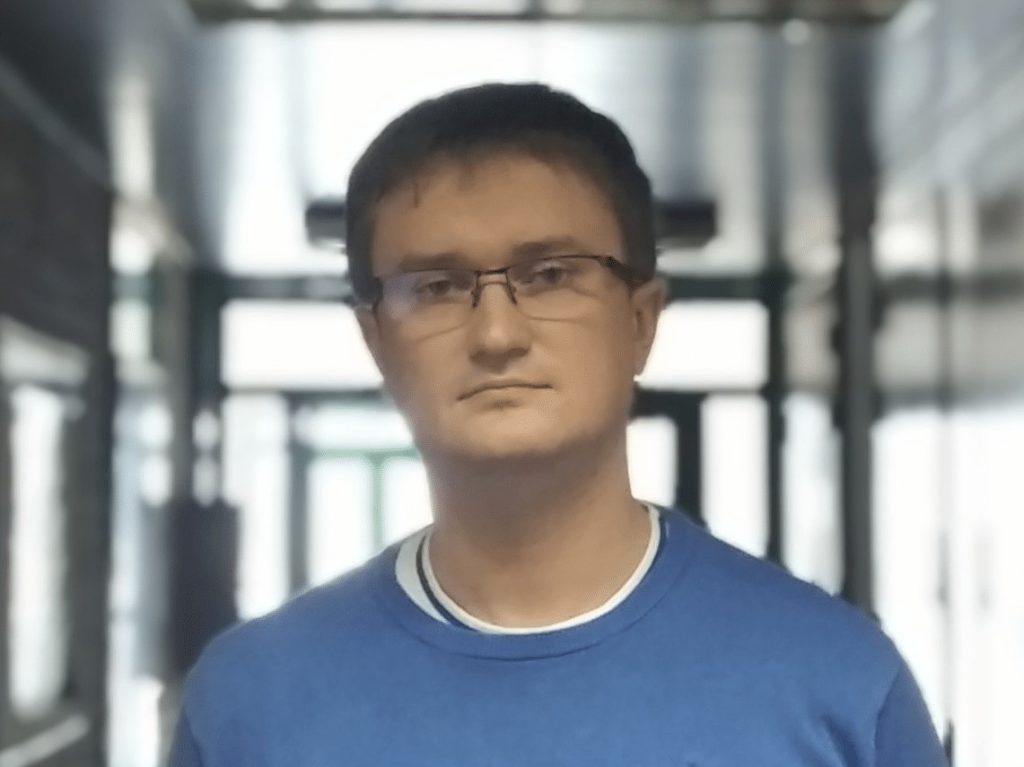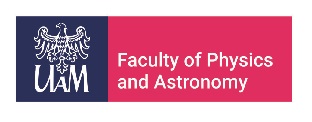
Dr. Eng. Stefan Stagraczyński
Former Member of ISQI
Scientific degrees
PhD in physics – 2017
Master of Science – 2012
Engineer degree – 2010
Research interests
keywords: modeling, spintronics, anisotropy, topology, band structures
Publications
2024 |
|
| 4. | Stefan Stagraczyński, Pavel Baláž, Mirali Jafari, Józef Barnaś, Anna Dyrdał Scientific Reports, 14 , pp. 25552, 2024. @article{Stagraczynski2024, title = {Magnetic ordering and dynamics in monolayers and bilayers of chromium trihalides: atomistic simulations approach}, author = {Stefan Stagraczyński and Pavel Baláž and Mirali Jafari and Józef Barnaś and Anna Dyrdał}, url = {https://doi.org/10.1038/s41598-024-75501-2}, doi = {10.1038/s41598-024-75501-2}, year = {2024}, date = {2024-10-26}, journal = {Scientific Reports}, volume = {14}, pages = {25552}, abstract = {We analyze magnetic properties of monolayers and bilayers of chromium iodide, CrI3, in two different stacking configurations: AA and rhombohedral ones. Our main focus is on the corresponding Curie temperatures, hysteresis curves, equilibrium spin structures, and spin wave excitations. To obtain all these magnetic characteristic, we employ the atomistic spin dynamics and Monte Carlo simulation techniques. The model Hamiltonian includes isotropic exchange coupling, magnetic anisotropy, and Dzyaloshinskii-Moriya interaction. As the latter interaction is relatively weak in pristine CrI3, we consider a more general case, when the Dzyaloshinskii-Moriya interaction is enhanced externally (e.g. due to gate voltage, mechanical strain, or proximity effects). An important issue of the analysis is the correlation between hysteresis curves and spin configurations in the system, as well as formation of the skyrmion textures.}, keywords = {}, pubstate = {published}, tppubtype = {article} } We analyze magnetic properties of monolayers and bilayers of chromium iodide, CrI3, in two different stacking configurations: AA and rhombohedral ones. Our main focus is on the corresponding Curie temperatures, hysteresis curves, equilibrium spin structures, and spin wave excitations. To obtain all these magnetic characteristic, we employ the atomistic spin dynamics and Monte Carlo simulation techniques. The model Hamiltonian includes isotropic exchange coupling, magnetic anisotropy, and Dzyaloshinskii-Moriya interaction. As the latter interaction is relatively weak in pristine CrI3, we consider a more general case, when the Dzyaloshinskii-Moriya interaction is enhanced externally (e.g. due to gate voltage, mechanical strain, or proximity effects). An important issue of the analysis is the correlation between hysteresis curves and spin configurations in the system, as well as formation of the skyrmion textures. |
| 3. | Verena Brehm, Stefan Stagraczyński, Józef Barnaś, Anna Dyrdał, Alireza Qaiumzadeh Physical Review Materials, 8 (5), pp. 054002, 2024. @article{Brehm2024, title = {Magnon dispersion and spin transport in CrCl3 bilayers under different strain-induced magnetic states}, author = {Verena Brehm and Stefan Stagraczyński and Józef Barnaś and Anna Dyrdał and Alireza Qaiumzadeh}, url = {https://doi.org/10.1103/PhysRevMaterials.8.054002 }, doi = {10.1103/PhysRevMaterials.8.054002}, year = {2024}, date = {2024-05-03}, journal = {Physical Review Materials}, volume = {8}, number = {5}, pages = {054002}, abstract = {Atomically thin van der Waals magnetic materials offer exceptional opportunities to mechanically and electrically manipulate magnetic states and spin textures. The possibility of efficient spin transport in these materials makes them promising for the development of novel nanospintronics technology. Using atomistic spin dynamics simulations, we investigate magnetic ground state, magnon dispersion, critical temperature, and magnon spin transport in CrCl3 bilayers in the absence and presence of compressive and tensile strains. We show that in the presence of mechanical strain, the magnon band gap at the Γ point and the critical temperature of the bilayer are increased. Furthermore, our simulations show that the magnon diffusion length is reduced in the presence of strain. Moreover, by exciting magnons through the spin Seebeck effect and spin Hall-induced torque, we illustrate distinctions between magnon spin transport in the antiferromagnetic state, under compressive strains, and ferromagnetic states, under tensile strains or in the unstrained case.}, keywords = {}, pubstate = {published}, tppubtype = {article} } Atomically thin van der Waals magnetic materials offer exceptional opportunities to mechanically and electrically manipulate magnetic states and spin textures. The possibility of efficient spin transport in these materials makes them promising for the development of novel nanospintronics technology. Using atomistic spin dynamics simulations, we investigate magnetic ground state, magnon dispersion, critical temperature, and magnon spin transport in CrCl3 bilayers in the absence and presence of compressive and tensile strains. We show that in the presence of mechanical strain, the magnon band gap at the Γ point and the critical temperature of the bilayer are increased. Furthermore, our simulations show that the magnon diffusion length is reduced in the presence of strain. Moreover, by exciting magnons through the spin Seebeck effect and spin Hall-induced torque, we illustrate distinctions between magnon spin transport in the antiferromagnetic state, under compressive strains, and ferromagnetic states, under tensile strains or in the unstrained case. |
2022 |
|
| 2. | M. Kaczor, I. Tralle, P. Jakubczyk, Stefan Stagraczyński, L. Chotorlishvili Switching of the information backflow between a helical spin system and non-Markovian bath Annals of Physics, 442 , pp. 168918, 2022, ISSN: 0003-4916. @article{Kaczor2022, title = {Switching of the information backflow between a helical spin system and non-Markovian bath}, author = {M. Kaczor and I. Tralle and P. Jakubczyk and Stefan Stagraczyński and L. Chotorlishvili}, url = {https://www.sciencedirect.com/science/article/pii/S0003491622000999?via%3Dihub}, doi = {10.1016/j.aop.2022.168918}, issn = {0003-4916}, year = {2022}, date = {2022-07-01}, journal = {Annals of Physics}, volume = {442}, pages = {168918}, abstract = {The dissipative dynamics of the spin chain coupled to the non-Markovian magnonic reservoir was studied. The chirality of the chain is formed due to the magnetoelectric coupling. We explored the sign of the trace distance derivative and found the alternating positive/negative periods in system’s time evolution. The negative sign is associated with the flow of information from the system to the bath and decrease in states distinguishability, while the positive sign is related to the flow of the information in the opposite direction and increase in distinguishability. We found the distinct effect of the applied electric and magnetic fields. While the Dzyaloshinskii–Moriya interaction and external electric field lead to reshuffling of the periods, the applied magnetic field leads to the swift positive–negative transitions. Thus, in the helical quantum rings coupled to the non-Markovian magnonic baths, it is possible to control the directions of information flow through the external fields.}, keywords = {}, pubstate = {published}, tppubtype = {article} } The dissipative dynamics of the spin chain coupled to the non-Markovian magnonic reservoir was studied. The chirality of the chain is formed due to the magnetoelectric coupling. We explored the sign of the trace distance derivative and found the alternating positive/negative periods in system’s time evolution. The negative sign is associated with the flow of information from the system to the bath and decrease in states distinguishability, while the positive sign is related to the flow of the information in the opposite direction and increase in distinguishability. We found the distinct effect of the applied electric and magnetic fields. While the Dzyaloshinskii–Moriya interaction and external electric field lead to reshuffling of the periods, the applied magnetic field leads to the swift positive–negative transitions. Thus, in the helical quantum rings coupled to the non-Markovian magnonic baths, it is possible to control the directions of information flow through the external fields. |
| 1. | Mir Ali Jafari, Małgorzata Wawrzyniak-Adamczewska, Stefan Stagraczyński, Anna Dyrdał, Józef Barnaś Spin valve effect in two-dimensional VSe2 system J. Magn. Magn. Mater., 548 , pp. 168921, 2022, ISSN: 0304-8853. @article{Jafari2022, title = {Spin valve effect in two-dimensional VSe2 system}, author = {Mir Ali Jafari and Małgorzata Wawrzyniak-Adamczewska and Stefan Stagraczyński and Anna Dyrdał and Józef Barnaś}, url = {https://www.sciencedirect.com/science/article/pii/S0304885321011215?via%3Dihub}, doi = {10.1016/j.jmmm.2021.168921}, issn = {0304-8853}, year = {2022}, date = {2022-03-15}, journal = {J. Magn. Magn. Mater.}, volume = {548}, pages = {168921}, abstract = {Vanadium based dichalcogenides, VSe2, are two-dimensional materials in which magnetic Vanadium atoms are arranged in a hexagonal lattice and are coupled ferromagnetically within the plane. However, adjacent atomic planes are coupled antiferromagnetically. This provides new and interesting opportunities for application in spintronics and data storage and processing technologies. A spin valve magnetoresistance may be achieved when magnetic moments of both atomic planes are driven to parallel alignment by an external magnetic field. The resistance change associated with the transition from antiparallel to parallel configuration is qualitatively similar to that observed in artificially layered metallic magnetic structures. Detailed electronic structure of VSe2 was obtained from DFT calculations. Then, the ballistic spin-valve magnetoresistance was determined within the Landauer formalism. In addition, we also analyze thermal and thermoelectric properties. Both phases of VSe2, denoted as H and T, are considered.}, keywords = {}, pubstate = {published}, tppubtype = {article} } Vanadium based dichalcogenides, VSe2, are two-dimensional materials in which magnetic Vanadium atoms are arranged in a hexagonal lattice and are coupled ferromagnetically within the plane. However, adjacent atomic planes are coupled antiferromagnetically. This provides new and interesting opportunities for application in spintronics and data storage and processing technologies. A spin valve magnetoresistance may be achieved when magnetic moments of both atomic planes are driven to parallel alignment by an external magnetic field. The resistance change associated with the transition from antiparallel to parallel configuration is qualitatively similar to that observed in artificially layered metallic magnetic structures. Detailed electronic structure of VSe2 was obtained from DFT calculations. Then, the ballistic spin-valve magnetoresistance was determined within the Landauer formalism. In addition, we also analyze thermal and thermoelectric properties. Both phases of VSe2, denoted as H and T, are considered. |


